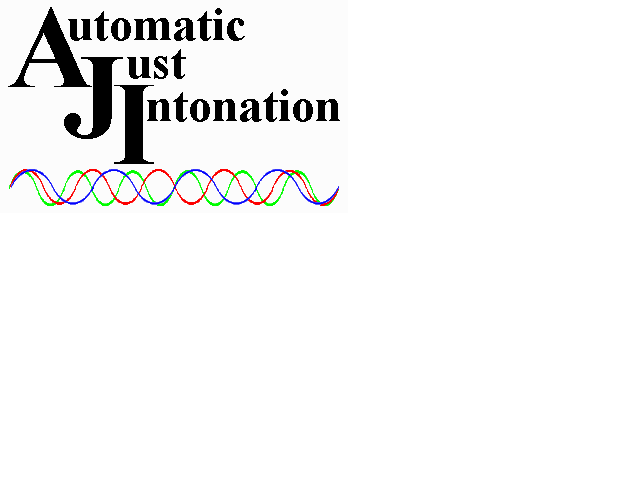
C C# D D# E F F# G G# A A# B C
1.000 1.122 1.260 1.335 1.498 1.682 1.888 2.000
1.059 1.189 1.414 1.587 1.782
The upper line contains the notes of the key, while the lower line has
the notes not belonging to the key (i.e the black notes when in C).
Firstly the Major chord is C-E-G. Ideally the notes are in the ratio 4-5-6 or 1-1.25-1.5 but the equitempered scale has 1-1.260-1.498. The difference of 1.498 from l.5 is probably only able to be detected by the very best musical ear, but the variation of 1.260 from 1.25 is noticeable though small. This chord sounds very close to correct.
Next, if we add the note A# to make dominant 7th chord, we have, C-E-G-A# which has relative frequencies of 1-1.260-l.498-1.782 while the ideal ratios are 4-5-6-7 or 1-1.25-1.5-1.75. The difference of 1.782 from 1.75 is very noticeable. and results in quite a strained sound. Part of the strain is due to using the ratio 7 which is less pleasing than 4 and 6 (more about this letter) but, much is due to the wrong frequency being used. It is true that composers use these differences for effect also, and so may not always want the ideal frequencies. It is also true that they cannot get the ideal frequencies even if they do want them.

Ideal Harmony: Having notes (in a chord or sequence) in perfect harmony, which means the frequencies are in (generally) small number ratios. For example for a major chord the ratios are 4-5-6.
Note Number: The notes are numbered, starting at zero on some note and going up one for each semitone. For example the C with a frequency of (about) 8 Hz could be note zero. Then middle C would be note number 60 because it is 5 octaves of 12 semitones/octave higher. The E above middle C would be note number 64 because it is 4 semitones higher.
Basic Scale Frequencies: The 7 notes of any one key have frequencies which are certain exact multiples of the key note. These ratios are shown:-
Note: do ray me fah soh lah ti doh Multiple: 1 9/8 5/4 4/3 3/2 5/3 15/8 2 Ratio: 24 27 30 32 36 40 45 48All of the above can be derived from the major chord ratios being 4-5-6 They derive from 3 chords, doh-me-soh, soh-ti-ray and fah-lah-doh.
2. Frequencies may vary to achieve ideal harmony within a chord.
(Set of simultaneous notes)
3. Frequencies may vary to achieve ideal harmonic progression.
(Set of Successive notes)
4. Frequencies may vary according to the key being played in, which may be indicated by some special means.
5. Chords may be achieved which were not really available previously, for example proper 7th chords which were previously a poor compromise.
6. The key may be kept track of and used to provide (additional) accompaniment.
7. The key may be kept track of by finding harmonies in chords and successive notes and working out the fundamental note.

Note No. 0 12 19 24 28 31 34 36 38 40 42 43 44 46 47 48 Ratio 1 2 3 4 5 6 7 8 9 10 11 12 13 14 15 16For ratios above 16 some notes have several possible ratios. The best ratio is given as well as the possible range.
Note 49 50 51 52 53 54 55 56 57 58 59 60
Best 17 18 19 20 21 22 24 25 27 28 30 32
Range 22- 25- 28- 30-
23 26 29 31
Note 61 62 63 64 65 66 67 68 69 70 71 72
Best 33 36 38 40 42 45 48 50 54 56 60 64
Range 33- 35- 37- 40- 42- 44- 47- 50- 53- 56- 59- 63-
34 36 39 41 43 46 49 52 55 58 62 65
Note 73 74 75 76 77 78 79 80 81 82 83 84
Best 66 72 75 80 84 90 96 100 108 112 120 128
Range 66- 70- 74- 79- 83- 88- 94- 99- 105- 111- 118- 125-
69 73 78 82 87 93 98 104 110 117 124 131
For higher values, continue to double the best values of the last line.
The above table shows for each ratio how many notes (semitones) the interval needs to be. Note that above note 46 all note numbers are present but above ratio 21 not all ratios are present (as best values).
The table is used as follows. Take any set of notes (chord or series) and count the lowest note as note 0 numbering the rest from there (eg C-E-G would be 0-4-7) then see if these numbers are in the above table. If they are not ALL present then add one to each of them and look again. Repeat this procedure until they are all present. At this point the fundamental note is the note with note number 0 taking the notes in the set as the final values after all the l's have been added. (e.g. for our C-E-G above we had 0-4-7 which are not all present, and we must add 1 a total of 24 times to get 24-28-31 before all the numbers are present in the table. This corresponds to ratios 4-5-6 and also tells us that the fundamental note is C 24 semitones or two octaves below the C in the chord).
An optional alternative is to not include the ratios 7, 11, 13 and possibly other higher prime numbers. This allows for possibly finding a better fit for some chords. If the chord has no better fit it will still find the ratio but with the numbers doubled (e.g. 7-9-11 will be found as 14-18-22) and the numbers may then be divided by two.
b. As listed except that certain numbers are not included as ratios, these being all prime numbers from 7 upwards.
c. The search of the ratio/note number table is not stopped when a match is found, but all matches (except those that can cancel) are found, then these are evaluated for the best one. This is done on a point scoring system and the patent includes the idea of point scoring. One possible points system is :-
1. For each possible solution found factorise all the ratios found for that solution.
2. Take the highest power of each prime in the factorisation and multiply it by a loading and add the results up to give a score. Some possible loading schemes are :- factor
2 3 5 7 11 13 etc. Notes
a. loading 1.39 3.30 8.05 13.6 26.4 33.3 n*log(n)
b. loading 0.00 0.69 1.39 1.79 2.30 2.48 log(n-1)
c. loading 0.69 1.10 1.61 1.95 2.40 2.56 log(n)
3. The possible solution with the lowest score is the one used.
Example:- Note numbers 24 26
Method 1 gives ratios 7 8 for the frequencies.
Method 2 gives ratios 8 9 for the frequencies.
Method 3 considers the ratios 7 8 and 8 9 and 9 10 and others
Factorising these gives 7 2^3 and 2^3 3^2 and 3^2 2*5 respectively.
The highest power of primes in the order 2 3 5 7 for these cases
are 3 0 0 1 and 3 2 0 0 and 1 2 1 0 respectively.
Loadings a scores them 17.77 (3*1.39+13.6) and 10.77 and 16.04.
Loadings b scores them 1.79 (3*0.00+1.79) and 1.38 and 2.77.
Loadings c scores them 8.16 (3*0.69+1.95) and 4.27 and 4.50.
In all cases the second option, ratios 8 9, is the best scoring.
1. Use the equitempered scale for the fundamental frequencies. This method may seem not to be in the spirit of the invention, but it has the advantage that small discrepancies do not accumulate (more about this) as is possible with some other methods. It is also easy to predict.
2. Base the basic scale frequencies. This depends on the key being declared beforehand. The method is technically more correct than 1, but declaring the key may be a nuisance.
3. Work out the key of the first chord (may be one note only) and then use its basic scale frequencies until a new fundamental indicates a key change. Future scale frequencies will be based on this scale until the next change. Each change will be based on the previous key, so that it is possible after several changes to return to the same key but NOT the same frequency.
4. The same as 3, but with a small factor to keep dragging the frequency back to the starting scale. A change of only 10% of the discrepancy towards the equitempered scale for each chord would prevent the discrepancy from growing to significant levels.
5. Use the frequency of the note in the scale of itself. This is the same as defining each key to be a frequency ratio of 3/2 to adjacent keys. Adjacent keys means keys with one more or less sharps or flats. The frequencies for the notes in the octave from middle C would be:-
C Db D Eb E F
264.0000 278.1234 297.0000 312.8889 334.1250 352.0000
F#/Gb G Ab A Bb B
370.8313/375.8906 396.0000 417.1852 445.5000 469.3333 501.1875
Chord A-C-D G-C-D F-C-D Ratios 6-7-8 6-8-9 6-9-10If C had the same frequency in each of the above examples, then D would be a frequency of 64/63 in the first and 80/81 in the third relative to the middle example. These are the two most common variations of any note, and are noticeable, being about a quarter of a semitone.
The piano (or other instrument) would still have the same electronics as described above for an electronic keyboard. It would also have pickups for each key to know what notes are played. Each string (or set of strings for one note) would have an adjustable stop near one end that was controlled by stepping motor to vary the effective length of the string (much like a human finger on a violin or guitar). The string would be sounded by the normal mechanism in the normal way. This device would also allow such effects as tremolo on a piano! There may well be problems to overcome in terms of wear on the string.
The detailed calculations for two small examples follow.

POLONAISE :- Wolfgang Amadeus Mozart in the key of F
Notes Note Ratios Fundamental Frequencies
Played Numbers Note Freq. Played
F3 A3 C5 12 16 31 4 5 12 -12 F 44 176 220 528
C4 F5 19 36 3 8 0 F 88 264 704
F3 A3 " 12 16 36 4 5 16 -12 F 44 176 220 704
C4 A5 19 40 3 10 0 F 88 264 880 *
" G5 19 38 1 3 19 C 264 264 792
F3 A3 G5 12 16 38 4 5 18 -12 F 44 176 220 792
" " F5 12 16 36 4 5 16 -12 F 44 176 220 704
C4 E5 19 35 2 5 7 C 132 264 660
" F5 19 36 3 8 0 F 88 264 704
E3 Bb3 C5 11 17 31 5 7 16 -17 C 33 165 231 528
C4 G5 19 38 1 3 19 C 264 264 792
E3 Bb3 " 11 17 38 5 7 24 -17 C 33 165 231 792
C4 Bb5 19 41 2 7 7 C 132 264 924
" A5 19 40 3 10 & 0 F 88 264 880 *
E3 Bb3 A5 11 17 40 5 7 27 -17 C 33 165 231 891 *
" " G5 11 17 38 5 7 24 -17 C 33 165 231 792
C4 F#5 19 37 4 11 @ -5 C 66 264 726
" G5 19 38 1 3 19 C 264 264 792
F3 A3 A5 12 16 40 4 5 20 -12 F 44 176 220 880
C4 A5 19 40 3 10 0 F 88 264 880
" F5 19 36 3 8 0 F 88 264 704
F3 G3 Bb5 12 14 41 8 9 42 -24 F 22 176 198 924
C4 Bb5 19 41 2 7 7 C 132 264 924
" G5 19 38 1 3 19 C 264 264 792
F3 A3 C6 12 16 43 4 5 24 -12 F 44 176 220 1056
" " A5 12 16 40 4 5 20 -12 F 44 176 220 880
C4 G5 19 38 1 3 19 C 264 264 792
" F5 19 36 3 8 0 F 88 264 704
. . . continued
Notes
1. All bar 1 frequencies are divisible by 44 and the key is always F, while
bar 2 are all divisible by 33 and key is C (see note 3) and bar 3 all
notes are divisible by 44 again.
2. The items above with a "*" are all A, but sometimes the frequency is
880 and at others 891. See note 3 also.
3. The item marked with a "&" has ratios 3 10, but under the alternative
method (points for ratios) the ratios could be 8 27. This would then
make the fundamental be C and agree with the rest of the bar. This A
would then be frequency 891. The alternative method of note finder
would certainly give 8 27.
4. The item marked "@" has the ratios 4 11, and 11 is not very common.
It seems that this was Mozart's intention as the fundamental is in
keeping with the surrounding chords. Another possibility is 16 45.
5. The item marked "#" has a ratio 42. If the variation of ratios feature
was included, 42 and 43 would both be considered, and 42 chosen.
6. All the frequencies are an exact number of Hz.

ROMANCE :- Ludwig Van Beethoven In the key of G Notes Note Ratios Fundamental Frequencies Played Numbers Note Freq. Played B4 28 1 28 B 495 495 C5 29 1 29 C 528 528 D5 31 1 31 D 594 594 G3 G4 12 24 1 2 12 G 198 198 396 B3 D4 " 16 19 24 5 6 8 -12 G 49.5 247.5 297 396 B3 D4 G4 16 19 24 5 6 8 -12 G 49.5 247.5 297 396 F3 B4/A4 11 28/26 3 8/7 -8 B 61.875 185.6+ 495/433.1+ C4 D4 G4 17 19 24 8 9 12 -19 C 33 *264 297 396 C4 D4 A4 17 19 26 7 8 12 -17 D 37.125 *259.9- 297 445.5 G3 B4 12 28 2 5 0 G 99 198 495 B3 D4 " 16 19 28 5 6 10 -12 G 49.5 247.5 297 495 B3 D4 G4 16 19 24 5 6 8 -12 G 49.5 247.5 297 396 B4 28 1 28 B 495 495 C5 29 1 29 C 528 528 D5 31 1 31 D 594 594 E3 G4 9 24 3 7 -10 A 55.6875 167+ 557- " G3 B3 " 9 12 16 24 6 7 9 14 -22 A 27.844- 167+ 195- 251- 390- " G3 B3 G4 9 12 16 24 6 7 9 14 -22 A 27.844- 167+ 195- 251- 390- E3 A4/G4 9 26/24 3 8/7 -10 A 55.6875 167+ 445+/390- " G3 C#4 F#4 9 12 18 23 12 14 20 27 -22 A 27.844- 167+ 195- 278+ 362- " G3 C#4 G4 9 12 18 24 6 7 10 14 -22 A 27.844- 167+ 195- 278+ 390- D3 A4 7 26 1 3 7 D 148.5 148+ 445+ " F#3 D4 " 7 11 19 26 4 5 8 12 -17 D 37.125 148+ 186- 297 445+ " F#3 D4 7 11 19 4 5 8 -17 D 37.125 148+ 186- 297 . . . continued Notes 1. At "*" C changes frequency from 264 to 259.9. This is because C and D occur together in two successive chords but their relationship changes because of the third note changing from G to A. 2. The pattern of the fundamental note in this piece is very interesting going:- BCD GGG BCD GGG BCD AAA AAA DDD ... That this is so is not at all obvious from the score, with the second BCD having the same melody as the second AAA, but quite different to the first BCD. 3. The fundamental frequency is given to high accuracy but space limitations meant that the note frequencies are truncated. The accurate frequencies can be derived from the fundamental times the ratios for each chord.
Return to Ray Tomes index page